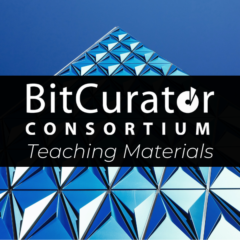| Advanced Digital Forensics Slides | Cal Lee, Kam Woods | BitCurator Hands-On Exercises, BitCuratorEdu Project, Educators | bitcurator-hands-on-exercises bitcuratoredu-project educators |
| Basic Linux Commands Exercise | Cal Lee, Kam Woods | BitCurator Hands-On Exercises, BitCuratorEdu Project, Educators | bitcurator-hands-on-exercises bitcuratoredu-project educators |
| BCC Digital Forensics Sample Data | Cal Lee, Kam Woods | BitCuratorEdu Project, Educators, Sample Data | bitcuratoredu-project educators sample-data |
| BitCurator and the DCC Lifecycle Model Assignment | Devan Donaldson | BitCuratorEdu Project, Educators | bitcuratoredu-project educators |
| BitCurator Guide for Educators | Hannah Wang, Jessica Farrell, Christopher A. Lee, Katherine Skinner | BitCuratorEdu Project, Educators | bitcuratoredu-project educators |
| BitCurator Talking Points Database | Hannah Wang, Nick Connizzo, Nancy McGovern, Kelsey O'Connell, Kari Smith, Suzanne Stasiulatis | BitCuratorEdu Project, Educators | bitcuratoredu-project educators |
| BitCuratorEdu Bibliography | Hannah Wang, Cal Lee | BitCuratorEdu Project, Educators | bitcuratoredu-project educators |
| BitCuratorEdu Curriculum Philosophy and Learning Objectives | Hannah Wang | BitCuratorEdu Project, Educators | bitcuratoredu-project educators |
| BitCuratorEdu Guidelines for Hosting Remote Internships | Jess Farrell, Sheridan Sayles, Meg Tuomala, Hannah Wang | BitCuratorEdu Project, Educators | bitcuratoredu-project educators |
| BitCuratorEdu Tool Inventory | Hannah Wang, Cal Lee | BitCuratorEdu Project, Educators | bitcuratoredu-project educators |
| Building an Anti-Racist Digital Curation Curriculum Workshop: Facilitators’ Guide | Jessica Farrell, Grace Muñoz, Ricky Punzalan, Hannah Wang | BitCuratorEdu Project, Educators | bitcuratoredu-project educators |
| Creating a Disk Image Using Guymager: Screencast Discussion Questions | Cal Lee, Hannah Wang | BitCuratorEdu Project, Educators, Screencast Discussion Questions | bitcuratoredu-project educators screencast-discussion-questions |
| Cross-Institutional Workflow Analysis Exercise | Rhiannon Bettivia, Hannah Wang | BitCuratorEdu Project, Educators, OSSArcFlow, OSSArcFlow Learning Objects | bitcuratoredu-project educators ossarcflow ossarcflow-learning-objects |
| Curating Potentially Sensitive Information in Digital Collections | Christopher (Cal) Lee, Kam Woods, Simson Garfinkel | BitCuratorEdu Project, Educators | bitcuratoredu-project educators |
| Datasets Library | Jess Farrell | BitCuratorEdu Project, Educators, Sample Data | bitcuratoredu-project educators sample-data |
| Digital Curation Pre-Class Survey | Grant Hurley | BitCuratorEdu Project, Educators | bitcuratoredu-project educators |
| Digital Curation Technologies Assignment | Devan Donaldson | BitCuratorEdu Project, Educators | bitcuratoredu-project educators |
| Digital Forensics Paper and Project Assignment | Jane Zhang | BitCuratorEdu Project, Educators | bitcuratoredu-project educators |
| Disk Images Exercise | Cal Lee, Kam Woods | BitCurator Hands-On Exercises, BitCuratorEdu Project, Educators | bitcurator-hands-on-exercises bitcuratoredu-project educators |
| Exiftool Exercise | Cal Lee, Kam Woods | BitCurator Hands-On Exercises, BitCuratorEdu Project, Educators | bitcurator-hands-on-exercises bitcuratoredu-project educators |
| Extracting Data from Office Documents Exercise | Cal Lee, Kam Woods | BitCurator Hands-On Exercises, BitCuratorEdu Project, Educators | bitcurator-hands-on-exercises bitcuratoredu-project educators |
| File System Attributes Exercise | Cal Lee, Kam Woods | BitCurator Hands-On Exercises, BitCuratorEdu Project, Educators | bitcurator-hands-on-exercises bitcuratoredu-project educators |
| Getting Started with the Virtual Machine: Screencast Discussion Questions | Cal Lee, Hannah Wang | BitCuratorEdu Project, Educators, Screencast Discussion Questions | bitcuratoredu-project educators screencast-discussion-questions |
| Installation of BitCurator VM and Introduction to Disk Imaging Assignment | Karen Gracy | BitCuratorEdu Project, Educators | bitcuratoredu-project educators |
| Introduction to BitCurator Slide Deck | Cal Lee | BitCuratorEdu Project, Educators | bitcuratoredu-project educators |
| Introduction to the BitCurator Software Environment: Screencast Discussion Questions | Cal Lee, Hannah Wang | BitCuratorEdu Project, Educators, Screencast Discussion Questions | bitcuratoredu-project educators screencast-discussion-questions |
| National Software Reference Library (NSRL) Exercise | Cal Lee, Kam Woods | BitCurator Hands-On Exercises, BitCuratorEdu Project, Educators | bitcurator-hands-on-exercises bitcuratoredu-project educators |
| OSSArcFlow Guide to OAIS Mapping Exercise | Hannah Wang | BitCuratorEdu Project, Educators, OSSArcFlow, OSSArcFlow Learning Objects | bitcuratoredu-project educators ossarcflow ossarcflow-learning-objects |
| PRONOM, Siegfried, and Brunnhilde Exercise | Cal Lee, Kam Woods | BitCurator Hands-On Exercises, BitCuratorEdu Project, Educators | bitcurator-hands-on-exercises bitcuratoredu-project educators |
| Safely Mounting Drives: Screencast Discussion Questions | Cal Lee, Hannah Wang | BitCuratorEdu Project, Educators, Screencast Discussion Questions | bitcuratoredu-project educators screencast-discussion-questions |
| Setting up Shared Folders: Screencast Discussion Questions | Cal Lee, Hannah Wang | BitCuratorEdu Project, Educators, Screencast Discussion Questions | bitcuratoredu-project educators screencast-discussion-questions |
| Using fiwalk to Generate Filesystem Metadata: Screencast Discussion Questions | Cal Lee, Hannah Wang | BitCuratorEdu Project, Educators, Screencast Discussion Questions | bitcuratoredu-project educators screencast-discussion-questions |
| Using the BitCurator Reporting Tool: Screencast Discussion Questions | Cal Lee, Hannah Wang | BitCuratorEdu Project, Educators, Screencast Discussion Questions | bitcuratoredu-project educators screencast-discussion-questions |
| Visual Workflow Diagram Translation Exercise | Hannah Wang | BitCuratorEdu Project, Educators, OSSArcFlow, OSSArcFlow Learning Objects | bitcuratoredu-project educators ossarcflow ossarcflow-learning-objects |
| Windows Artifacts Exercise | Cal Lee, Kam Woods | BitCurator Hands-On Exercises, BitCuratorEdu Project, Educators | bitcurator-hands-on-exercises bitcuratoredu-project educators |
| Workflow Modeling Lesson and Exercise | Cal Lee | BitCuratorEdu Project, Educators | bitcuratoredu-project educators |
